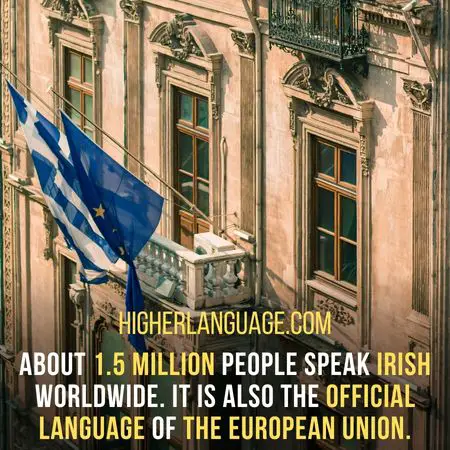If you are an Irish speaker and want to experience learning a new language. Then learning about languages similar to Irish is your best choice
[toc]
Languages similar to your native language are easy and faster to learn. Continue reading to explore in depth.
5 Languages Similar To Irish
The Irish language is a Celtic language spoken in Ireland. It is also spoken by small groups in the United Kingdom, the United States, and Canada.

There are about 1.5 million Irish speakers worldwide. The Irish language is also one of the official languages of the European Union.
Celtic languages are a group of Indo-European languages that originated in Europe.
Since Irish is a Celtic language and, as such, is closely related to other Celtic languages like Scottish Gaelic, Manx, and Welsh.
Additionally, due to historical connections, the Irish also has some similarities with Languages from the Brythonic branch of Celtic, like Breton and Cornish.
These related languages can be a helpful resources for English speakers learning Irish.
Some people might not know this, but many languages are similar to Irish . Here are 5 of the most notable languages similar to Irish:
1. Scottish Gaelic:
Scottish Gaelic language is spoken in the Scottish Highlands, Isle of Skye, and the Hebrides.
A minority also speaks it in Nova Scotia. About 60,000 people speak it in Scotland.
There are various similarities and differences between Irish and Scottish Gaelic.
Similarities:
Gaelic is similar to Irish in many ways. For example, both languages use the Latin alphabet and have similar grammar structures.
For example, both languages have subject-verb-object word order.
In addition, both languages have a rich oral tradition and are known for their poetic nature.
Another similarity between both languages is that they both have a rich history and culture.
Finally, the grammar of both languages is also very similar.
Differences:
However, there are also some notable differences between the two languages. For instance, Scottish Gaelic has a larger number of consonants than Irish.
Additionally, Scottish Gaelic pronunciation has several different dialects, making it difficult for speakers of other languages to understand.
In addition, Gaelic has several loanwords from Scottish English and Latin.
There are a total of eighteen letters in Gaelic. While there are a total of twenty-four letters in the Irish alphabet
While Gaelic and Irish share many similarities, they are two distinct languages.
Gaelic is the primary language spoken in Scotland, while Irish is the first language of Ireland. However, both languages are part of the Celtic language family.
2. Manx:
Manx is spoken in the Isle of Man, between Ireland and Great Britain.
Like Gaelic and Irish, Manx is a Celtic language. However, Manx is more closely related to Scottish Gaelic than Irish.

About 1,800 people speak it. Manx is considered an endangered language because so few people speak it.
Similarities:
Manx and Irish are similar in many ways. Both languages use the Latin alphabet and have similar grammar and syntax.
They also share a lot of vocabulary. Another similarity is that English has influenced both languages.
Finally, both languages are official languages of the European Union.
Differences:
However, there are some differences between the two languages. For example, Manx has more influence from Scottish Gaelic than Irish does.
Additionally, Manx pronunciation is different from both Gaelic and Irish. Finally, Manx has lost some features in Irish, like the genitive case and the dual number.
Despite these differences, speakers of Irish and Manx can usually understand each other.
3. Cornish:
Cornish is spoken in Cornwall, in the southwest of England. It is a Celtic language, like Irish, Welsh, and Breton. About 3,500 people speak it.
Cornish is not as similar to Irish as Manx is, but speakers of the two languages can still understand each other to some degree.
Similarities:
Some features in both Cornish and Irish are similar. They are Both languages have initial mutations.
For example, in Irish, the word “cat” would be “cait” when it appears before a vowel sound.
Both languages also have lenition when a voiced consonant becomes voiceless. So, the word “cat” would become “chat” when lenited.
Both languages have similar grammatical structures and use VSO (verb-subject-object) word order.
Both languages have similar pronoun systems, with first, second, and third-person singular and plural forms.
In addition, both languages use inflection to show grammatical information, and both languages have similar grammatical structures.
For example, both languages use genitive cases to show possession.
Another similarity is that both languages use initial mutation.
For example, the word for “house” in Cornish is “tavas,” which changes to “davas” when it is used as the subject of a sentence.
Differences:
There are several differences between Cornish and Irish. For one thing, the Cornish has been more influenced by the English than the Irish.
Additionally, Cornish has lost some common features in other Celtic languages, like the use of the passive voice.
Irish has more dialects than Scottish Gaelic, and the two languages have different lexical sets ( words that are unique to each language).
Cornish has lost the genitive case, while the Irish still has it. Cornish does not have verbal nouns, while Irish does.
For example, the verb-noun ‘to write’ in Irish is scríobh, while in Cornish, it would just be ‘writing.’
In Cornish, the preposition ‘to‘ is always placed after the verb. While in Irish, it can be placed before or after the verb.
Cornish and Irish are not mutually intelligible, but speakers of the two languages can still understand each other.
4. Welsh:
Welsh is spoken in Wales, and like Irish, it is a Celtic language. About 722,000 people speak Welsh.

Welsh is written in the Latin alphabet and has a unique writing system called Cynghanedd.
Welsh belongs to the Brythonic branch of Celtic languages, while Irish belongs to the Goidelic branch.
Similarities:
Welsh is not as similar to Irish as Cornish is, but the two languages share some similarities.
Welsh and Irish have inflectional grammar (the endings of words change to indicate grammatical information), and both languages have VSO (verb-subject-object) word order.
For example, the sentence ‘I am writing a letter” would be ‘Rydw i’n ysgrifennu llythyr’ in Welsh and ‘Táim ag scríobh litir’ in Irish.
Both languages have 18 consonants and five vowels. Both languages use mutations (changes in pronunciation).
For example, in Welsh, the consonant at the beginning of a word changes when certain other words precede the word. That is similar to the lenition that occurs in Irish.
Differences:
Although Welsh and Irish share some similarities, there are also some significant differences between the two languages.
For example, while Welsh has grammatical gender, Irish does not.
Welsh grammar is different from that of Irish. For example, Welsh uses verbal nouns (nouns that refer to an action or event), while the Irish do not.
In Welsh, the preposition ‘to‘ is always placed after the verb. While in Irish, it can be placed before or after.
One of the main differences between the Welsh and the Irish is that Welsh uses mutations more extensively than the Irish do.
Mutations are changes to the spelling or sound of a word. That occurs when that word is next to another.
There are three types of mutations in Welsh: lenition, ellipses, and nasalization. Irish also have three types of mutations: lenition, ellipsis, and h-prefixing.
Welsh and Irish are not mutually intelligible, but speakers of the two languages can still understand each other.
So while there are some similarities between Welsh and Irish, there are also some significant differences.
Welsh might be a good option if you’re looking for a language similar to Irish.
5. Breton:
Breton is spoken in Brittany, an area in the northwest of France. Breton is a Celtic language, like Irish, and it is also related to Welsh and Cornish.

Although Breton is not as widely spoken as it once was, there are still about 200,000 speakers of the language.
Here are some similarities and differences between Irish and Breton:
Similarities:
Breton and Irish share some similarities in their grammar and vocabulary.
For example, both languages use initial consonant mutations (changes to the beginning of words depending on how they are used in a sentence).
Both have inflected prepositions (prepositions that change form depending on the case of the noun they are referring to).
Both languages have VSO (verb-subject-object) word order. For example, the Irish sentence “Tá sé á lúbadh” (He is washing) would be translated to “E LaVar” in Breton.
Both languages are Celtic languages and thus share a common ancestry.
They also have inflectional grammar, meaning words can change form depending on their function in a sentence.
Additionally, both languages use the Latin alphabet (although Breton uses some additional letters that Irish does not).
Finally, Both languages have lenition and ellipses. For example, in Irish, the word for “cat” would be pronounced “kat” if it were at the beginning of a sentence.
However, if the word “cat” comes after the word “the” (as in “the cat“), it is pronounced as “chat“. That is because of the sound of the word.
Differences:
There are also some significant differences between Breton and the Irish.
For example, Breton has a much more complex system of noun declensions (the way a noun changes form depending on its function in a sentence) than Irish.
Breton also has grammatical gender, whereas Irish does not.
Additionally, while both languages use the Latin alphabet, Breton uses some additional letters (such as “ç” and “x“) that are not used in Irish.
Finally, the two languages have different vocabularies, with some words having different meanings in Breton and Irish.
For example, the Irish word “céad” can mean “first” or “hundred“, while the Breton word “kentañ” only means “first.”
Breton has more consonants than Irish. Breton has a different vowel system than the Irish. For example, in Irish, Breton’s front rounded vowel “y” does not exist.
Despite these differences, both languages are members of the Celtic language family and share many features in common.
So, while Breton and the Irish are not the same, there are still many similarities. If you are interested in learning Irish, then learning Breton is also a good option.
Is English Similar To Irish?
While English is not a Celtic language, it does have some similarities to Irish.
For example, both languages use the Latin alphabet and have many words of Latin origin.
Both languages also have similar grammar structures.
For instance, both languages use prepositions (words like “in”, “on”, and “of”) to indicate relationships between words in sentences.
However, there are also some major differences between English and Irish.
For instance, Irish has case endings (changes to words depending on their grammatical role in a sentence), while English does not.

Plus, you cannot understand English if you only speak Irish. While there are some similarities between the two languages, they are not the same language.
So if you want to learn English, you’ll need to put in some extra effort to learn the unique aspects of the language.
Final Thought:
So, there you have it! A brief overview of some languages similar to Irish.
While they may share some similarities, each language has unique quirks that make it distinct from the rest.
Irish is a unique language itself with some interesting features.
If you’re interested in learning Irish, or another Celtic language, be prepared to put in some extra effort to learn the language’s quirks.
But it’ll be worth it in the end – being able to speak a beautiful and rare language is an incredible experience.